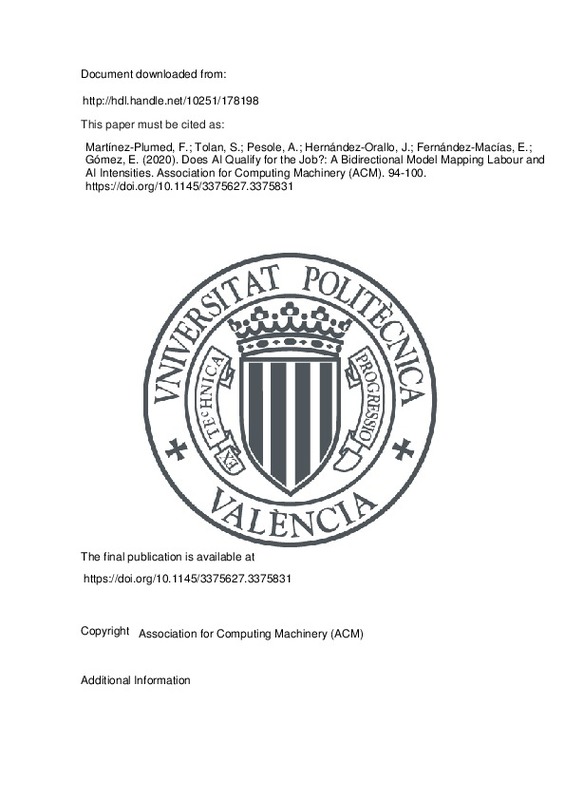JavaScript is disabled for your browser. Some features of this site may not work without it.
Buscar en RiuNet
Listar
Mi cuenta
Estadísticas
Ayuda RiuNet
Admin. UPV
Does AI Qualify for the Job?: A Bidirectional Model Mapping Labour and AI Intensities
Mostrar el registro sencillo del ítem
Ficheros en el ítem
| dc.contributor.author | Martínez-Plumed, Fernando
|
es_ES |
| dc.contributor.author | Tolan, Songül
|
es_ES |
| dc.contributor.author | Pesole, Annarosa
|
es_ES |
| dc.contributor.author | Hernández-Orallo, José
|
es_ES |
| dc.contributor.author | Fernández-Macías, Enrique
|
es_ES |
| dc.contributor.author | Gómez, Emilia
|
es_ES |
| dc.date.accessioned | 2021-12-13T07:07:32Z | |
| dc.date.available | 2021-12-13T07:07:32Z | |
| dc.date.issued | 2020-02-08 | es_ES |
| dc.identifier.isbn | 978-1-4503-7110-0 | es_ES |
| dc.identifier.uri | http://hdl.handle.net/10251/178198 | |
| dc.description.abstract | [EN] In this paper we present a setting for examining the relation between the distribution of research intensity in AI research and the relevance for a range of work tasks (and occupations) in current and simulated scenarios. We perform a mapping between labour and AI using a set of cognitive abilities as an intermediate layer. This setting favours a two-way interpretation to analyse (1) what impact current or simulated AI research activity has or would have on labour-related tasks and occupations, and (2) what areas of AI research activity would be responsible for a desired or undesired effect on specific labour tasks and occupations. Concretely, in our analysis we map 59 generic labour-related tasks from several worker surveys and databases to 14 cognitive abilities from the cognitive science literature, and these to a comprehensive list of 328 AI benchmarks used to evaluate progress in AI techniques. We provide this model and its implementation as a tool for simulations. We also show the effectiveness of our setting with some illustrative examples. | es_ES |
| dc.description.sponsorship | This material is based upon work supported by the EU (FEDER), and the Spanish MINECO under grant RTI2018-094403-B-C3, the Generalitat Valenciana PROMETEO/2019/098. F. Martínez-Plumed was also supported by INCIBE (Ayudas para la excelencia de los equipos de investigación avanzada en ciberseguridad), the European Commission (JRC) HUMAINT project (CT-EX2018D335821-101), and UPV (PAID-06-18). J. H-Orallo is also funded by an FLI grant RFP2-152. | es_ES |
| dc.language | Inglés | es_ES |
| dc.publisher | Association for Computing Machinery (ACM) | es_ES |
| dc.relation.ispartof | AIES '20: Proceedings of the AAAI/ACM Conference on AI, Ethics, and Society | es_ES |
| dc.rights | Reserva de todos los derechos | es_ES |
| dc.subject | Labour market | es_ES |
| dc.subject | Tasks | es_ES |
| dc.subject | AI intensity | es_ES |
| dc.subject | AI impact | es_ES |
| dc.subject | AI benchmarks | es_ES |
| dc.subject | Simulation | es_ES |
| dc.subject.classification | LENGUAJES Y SISTEMAS INFORMATICOS | es_ES |
| dc.title | Does AI Qualify for the Job?: A Bidirectional Model Mapping Labour and AI Intensities | es_ES |
| dc.type | Comunicación en congreso | es_ES |
| dc.type | Capítulo de libro | es_ES |
| dc.identifier.doi | 10.1145/3375627.3375831 | es_ES |
| dc.relation.projectID | info:eu-repo/grantAgreement/AEI/Plan Estatal de Investigación Científica y Técnica y de Innovación 2017-2020/RTI2018-094403-B-C32/ES/RAZONAMIENTO FORMAL PARA TECNOLOGIAS FACILITADORAS Y EMERGENTES/ | es_ES |
| dc.relation.projectID | info:eu-repo/grantAgreement/FLI//RFP2-152/ | es_ES |
| dc.relation.projectID | info:eu-repo/grantAgreement/EC//CT-EX2018D335821-101/ | es_ES |
| dc.relation.projectID | info:eu-repo/grantAgreement/UPV//PAID-06-18/ | es_ES |
| dc.relation.projectID | info:eu-repo/grantAgreement/UPV-VIN//SP20180210//A collaboratory for the evaluation, comparison and classification of Artificial Intelligence/ | es_ES |
| dc.relation.projectID | info:eu-repo/grantAgreement///PROMETEO%2F2019%2F098//DEEPTRUST/ | es_ES |
| dc.rights.accessRights | Abierto | es_ES |
| dc.contributor.affiliation | Universitat Politècnica de València. Departamento de Sistemas Informáticos y Computación - Departament de Sistemes Informàtics i Computació | es_ES |
| dc.description.bibliographicCitation | Martínez-Plumed, F.; Tolan, S.; Pesole, A.; Hernández-Orallo, J.; Fernández-Macías, E.; Gómez, E. (2020). Does AI Qualify for the Job?: A Bidirectional Model Mapping Labour and AI Intensities. Association for Computing Machinery (ACM). 94-100. https://doi.org/10.1145/3375627.3375831 | es_ES |
| dc.description.accrualMethod | S | es_ES |
| dc.relation.conferencename | Third AAAI/ACM Conference on Artificial Intelligence, Ethics, and Society (AIES 2020) | es_ES |
| dc.relation.conferencedate | Febrero 07-08,2020 | es_ES |
| dc.relation.conferenceplace | New York, USA | es_ES |
| dc.relation.publisherversion | https://doi.org/10.1145/3375627.3375831 | es_ES |
| dc.description.upvformatpinicio | 94 | es_ES |
| dc.description.upvformatpfin | 100 | es_ES |
| dc.type.version | info:eu-repo/semantics/publishedVersion | es_ES |
| dc.relation.pasarela | S\431995 | es_ES |
| dc.contributor.funder | European Commission | es_ES |
| dc.contributor.funder | Future of Life Institute | es_ES |
| dc.contributor.funder | European Regional Development Fund | es_ES |
| dc.contributor.funder | Instituto Nacional de Ciberseguridad | es_ES |
| dc.contributor.funder | Universitat Politècnica de València | es_ES |







![[Cerrado]](/themes/UPV/images/candado.png)

